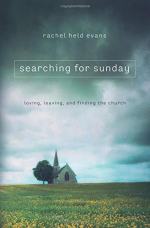|
This section contains 732 words (approx. 2 pages at 400 words per page) |

|
Searching For Sunday Summary & Study Guide Description
Searching For Sunday Summary & Study Guide includes comprehensive information and analysis to help you understand the book. This study guide contains the following sections:
This detailed literature summary also contains Topics for Discussion on Searching For Sunday by Rachel Held Evans.
The following version of this book was used to create this study guide: Evans, Rachel Held. Searching for Sunday. Nelson Books, an Imprint of Thomas Nelson; HarperCollins Christian Publishing, Inc. 2015.
The author offers her considerations of different faith practices and perspectives within a framework defined by seven major sacraments of Christian religious practice. In that practice, a sacrament is an activity made sacred as a result of being infused with the spirit of God through ritualization, prayer, or some combination thereof.
The book begins with a Forward by author and public speaker Glennon Doyle, who offers praise and support for the author and her perspectives on Christianity, and on faith in general. The author then offers a Forward in which she introduces herself and her struggles. She also offers a perspective on Christian faith in general, defining its many facets and manifestations as being anchored in beliefs about the teachings, death, and resurrection of Jesus.
Part I offers the first of the author’s considerations of her own faith, and of faith in general, within the context of commentary on the Christian practice of Baptism. This first sacrament in the book’s series of seven is defined by an encounter with some form of water that initiates a believer into the life and ways of Jesus. Throughout Part I, the author considers different types of baptism, and the power and metaphoric meaning of different forms of water. She also introduces several details of her personal life and faith practice that she explores throughout the book to come.
The author continues these considerations within the framework of Confession, in Part II, and Holy Orders, in Part III. The narratives of these two chapters are, on one level, defined by the author’s personal story of leaving her church, discovering the lingering influence of what she has left behind as a result of her departure, and joining with a small group of friends to start a small independent church called The Mission. At the end of Part III, The Mission has failed, and the author has been left to continue her journey through both faith and doubt without a church community to shape and anchor that journey.
In Part IV, the author’s considerations are shaped by her understanding of what is arguably one of the most significant sacraments in the Christian church. This is the experience of Communion which, as she describes it, ritualizes the consumption of some form of food in a way that evokes both the last meal Jesus ate before he was crucified and what he said during that last meal. She describes how his words, comparing his body and blood to the bread and wine being consumed at the table, are echoed and paraphrased throughout all Christian churches in their practice of offering and sharing food. The author here suggests that for her and for many Christians around the world this act, in all its variations, is perhaps the closest that many become to connecting with and enacting the actual spirit and practices of Jesus.
Part V takes the considerations of Part IV one step further, considering how persons connect with Jesus and with faith in relation to the sacrament of Confirmation. That sacrament, in the author’s perspective and writing, offers Christians an opportunity to more fully experience God’s Spirit, deepening and sustaining the connection established through Communion and carrying it out into the everyday. Here, the book offers its primary consideration of the idea that that Spirit can be found in surprising places or people, and can manifest in unexpected ways. Part VI, in turn, takes this idea further still, as it describes ways in which the Spirit can be felt and/or triggered in encounters with holy sanctified oils, even in moments of illness and death.
The author concludes her considerations in Part VII, with a consideration of how the sacrament of Marriage can be likened to the “marriage” between humanity and Spirit, as manifest in both the church and in daily life. Finally, there is an Epilogue, in which the author discusses how for her and many others, the question of how to live a life with and in faith continues to be a mystery, but one that is worth journeying into in the hopes of finding glimmers of truth in the darkness, confusion, and stress of daily life as a Christian.
Read more from the Study Guide
|
This section contains 732 words (approx. 2 pages at 400 words per page) |

|



